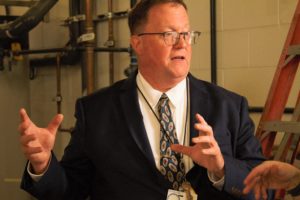By Tom Travis
On the heels of a major GLWA water line break in mid-August, a federal representative, EPA Region-5 Administrator, Debra Shore, toured the Flint Water Plant and praised the Flint Water Department staff.
The EPA’s Region 5 is the largest of its 10 regions. Region 5 comprises six of the eight Great Lakes states, including 35 tribal nations.
“Their [The Flint Water Department] swift action and smooth response ensured the safety and availability of Flint’s drinking water was undisturbed. Let me say, this is huge,” Shore said.
The GLWA water main break necessitated the Flint Water Department use the newly completed secondary water line that pulls water from Genesee County Drain Commission water source.

Environmental Protection Agency (EPA) Regional 5 Director Debra Shore (right) and Environment, Great Lakes and Energy (EGLE) Director Liesl Clark touring the updated Flint Water Plant on Tuesday. (Photo by Tom Travis)
The GLWA water main break in mid-August prompted Gov. Gretchen Whitmer to issue a state of emergency across five regions in southeast Michigan. Genesee County did not need to be included in the state of emergency because the Flint Water Department had recently completed the embattled task of a secondary water line.
This secondary water line is sourced from the Genesee County Drain Commission (GCDC) which draws its water from Lake Huron.
Flint’s secondary water line was approved back in 2018 by EGLE and the EPA. The approval of the contract was embattled between city administration officials and city council until 2021. The completed secondary line involves nearly seven miles of pipe in northeastern Genesee County, from Frances Road to the new Chemical Feed Building on the Flint Water Plant campus located at 4500 N. Dort Hwy.
The city of Flint’s main source of water is through GLWA. In 2017 the city council approved, by a 5-4 vote, a 30-year contract to purchase water through GLWA, until the year 2047. The GCDC provides a secondary water source to the city through the newly completed secondary water line. Both GLWA and GCDC’s initial source of water is Lake Huron.
“This is really a state of the art system.” – EPA Region 5 Administrator Debra Shore
“I’ve been to Flint before and I’m glad to be back and will continue to visit as I see the great work the water department has been doing to bring this utility into the twenty-first century,” Shore said.
“This is really a state of the art system. It’s because of the significant investment that have been made and a great deal of hard work which was on full display last week when the Great Lakes Water Authority experienced a significant water main break.
“This is the kind of thing you plan for but certainly don’t want it to happen but you want to be ready,” she said.
“And Flint was way ready. The team responded quickly and followed established protocols and were able to switch over to the back-up secondary water supply from the Genesee County Drain Commission (GCDC).
EPA Region 5 Director Debra Shore speaks at a press conference held at the Flint Water Plant on Tuesday. (Photo by Tom Travis)
“This is what all the hard work and investment over the last few years is all about. Because a few years ago this back-up water supply didn’t exist. It’s not a question of ‘if’ a water system will experience an emergency but ‘when.’
“We’re all living in communities with aging infrastructure and pipes. This is why the bipartisan infrastructure law that was passed last Fall because not every community would be able to protect it’s drinking water as Flint did this last week. This country’s outdated and overgrown water infrastructure threatens our nations security and economy.
“The bipartisan infrastructure law delivers more than $50 billion to the EPA to improve our nations water and waste water infrastructure. It’s the single largest investment into our country’s water funding the federal government has ever made. With it we’ll help communities build more resilient systems, protect health and safety and bring peace of mind,” Shore explained.
Secondary Water Line put to the test
On the eighth anniversary of the Flint Water Crisis, April 25, 2022, Mayor Sheldon Neeley announced the long-awaited completion of a secondary water line intended to ensure a source for safe and clean drinking water for Flint residents should the main source ever be compromised. The test of the new secondary water line came suddenly in mid-August.

City of Flint DPW Director Mike Brown (left) and City Administrator Clyde Edwards (right) listening to Water Plant Supervisor Scott Dungee speak to the media about the underground connections of the secondary water line. (Photo by Tom Travis)
The Secondary Water Source Connection was a $17 million project for a backup water source in an emergency. This project provides a link between the City of Flint’s existing water infrastructure and the Genesee County Drain Commission as an emergency backup in case service from GLWA is ever disrupted.
Both the Genesee County Drain Commission and GLWA source their water from Lake Huron, Mayor Neeley clarified in an April 25, 2022 press release.
At Tuesday’s press conference, City Administrator Clyde Edwards told members of the press the day was an opportunity to see the work of the upgrades in its entirety after completion.
“When we arrived as an administration in November 2019 parts of the project were already started like the Dort Reservoir. But we pushed on to get the chemical feed building completed as well as the secondary water line,” Edwards said.
Department of Public Works (DPW) Director Mike Brown said the city’s next water infrastructure project is to upgrade the Cedar Street reservoir, scheduled to begin in 2023. He explained that these upgrades will give the city residents 40 million gallons of water in storage, split between the Dort and Cedar Street reservoirs. “That’s a little over four days of supply if something were to happen,” Brown said.

DPW Director Mike Brown speaking to the media at a 2021 press conference in the Water Plant’s new Chemical Feed Building. (Photo by Tom Travis)
“We have other projects that will come up that have to be done, for instance, a water line that needs to be replaced in the city’s northwest transmission main,” Brown predicted.
“That line is more than 70 years old. When we have a hole in that line it can shoot water 50 feet into the air. It takes a lot to get that under control.”
Brown explained the city has $167 million to spend, including $100 million from federal WIIN (Water Infrastructure Improvements for the Nation Act) funds, $67 million from the State multiple areas for Flint infrastructure. Brown added Cedar Street will cost $12 million, bringing the total to be spent on water infrastructure projects to $180 million.
In addition the water mains along Miller Road are being replaced as the new road is laid throughout the summer.
The media asked Brown how the city intends to fix the “trust” issue with Flint residents about water infrastructure and safety. “By being transparent and answering every question that comes at us,” said Brown. “I understand people being upset because of the water crisis, feeling that they were fooled,” he noted.
Brown said he did not work for the City when the Flint Water Crisis started in 2014.
Liesl Clark, director of the Michigan Department of Environment, Great Lakes and Energy (EGLE) accompanied EPA Region 5 Director Shore. Clark said, “This is an unsung victory, [the completed secondary waterline] This was not an easy project.”
Clark commended the water department for their “incredible work.” And she expressed thanks for the partnerships between the City of Flint and multiple departments at the State level.

EGLE Director Liesl Clark at Tuesday’s press conference at Flint’s Water Plant. (Photo by Tom Travis)
Shore addressed the emerging concern over “the suite of chemicals called PFAS.” She explained that the EPA is now seeking to do more testing of community water systems, wells, and soil all over the region. “We will establish new limits on maximum limits,” she said. “We don’t know what they’ll be at this point but probably lower than we think they are now. Michigan has been leading among the states to establish the limits and regular testing.”
“The federal EPA issued a new health advisory for four of the suite of PFAS in June that lowered the level that over a life time of expunging you need to be careful. There’s an effort underway to conduct the science but it takes time. Estimates that you’ll see some new rule making and new efforts perhaps early next year,” explained Shore.
Recent chemical spill into the Flint River addressed
Clark addressed questions over a recent Flint River chemical spill by saying her department is operating with an “abundance of caution” because they are still trying to fully understand what that product was that spilled into the river, not only what effect it has on the ecosystem but more importantly on people interacting with the river water. “This spill wasn’t just gasoline or just oil — that’s part of the reason we’re trying to be really cautious and have it fully characterized,” Clark stated.
The State of Michigan’s PFAS response website explains, “Per and poly – fluoroalkyl substances (PFAS) are a large group of man-made chemicals that include perfluorooctanoic acid (PFOA) and perfluorooctanesulfonic acid (PFOS). PFAS have been used globally during the past century in manufacturing, firefighting and thousands of common household and other consumer products. These chemicals are persistent in the environment and in the human body – meaning they don’t break down and they can accumulate over time.
The Natural Resources Defense Council’s (NRDC) website, in an article published April 6, 2022, further explains, “PFAS are also toxic at extremely low parts per trillion, posing significant risks to our health. And if you’re wondering why they’re called “forever chemicals,” it’s because they are nearly indestructible. Unfortunately, PFAS are almost impossible to avoid. They are found in our homes, our offices, our supermarkets—practically everywhere.”
EVM Managing Editor Tom Travis can be reached at tomntravis@gmail.com



You must be logged in to post a comment.